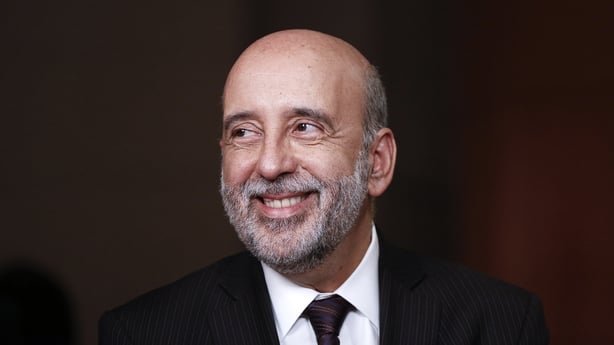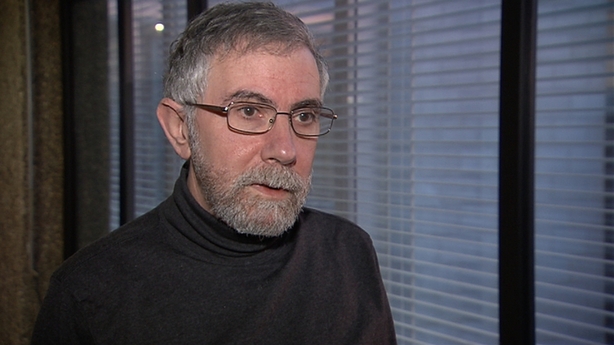Here we go again. The leprechauns are restive.
No, it's not the impending festivities around St Patrick’s Day. It’s much worse than grown adults sporting fake orange beards and tams o'shanter.
It’s Leprechaun Economics 2: Euro Edition.
Back in the early part of this year, the CSO and Eurostat reported that initial estimates suggested the Irish economy grew in GDP terms by 3.5% in the final three months of last year.
That made growth across last year in Ireland an estimated 12.2%.
Growth in the euro area in the final three months of last year was 0.1%, which was a surprise. It’s widely understood that the stellar Irish growth figure "saved" the euro area from slipping into negative territory.
Growth in the euro area in 2022 was 3.5% which means Ireland’s economy leapt ahead three and a half times faster last year than our euro neighbours.
In a further update, the European Commission’s Winter Economic Forecast said a 92% increase in investment in Ireland, predominantly by multinationals, in the third quarter last year compared to the previous quarter contributed to ‘much stronger than anticipated’ growth here.
There were a few grumbles, raised eyebrows and shrugged shoulders at yet another incredible performance from Champion Irish GDP.
This is because for some years now, reporting GDP has been accompanied by another measure like GNI* (Modified Gross National Income or, in the lingo, "GNI star") or Modified Domestic Demand; both of which attempt to give a better idea of activity in the domestic economy by leaving out some activities associated with multinationals.
In other words, it’s now pretty much accepted here at least that GDP paints an exaggerated picture of what’s going on in the economy.
The Irish numbers are so big they are now distorting the view of what's going on in the euro economy.
But these qualifying measures will have to wait until early next month when the CSO publishes national accounts for the final quarter of last year. So, GDP has been able to shine on its own.
And when the Financial Times asked the Governor of the Central Bank, Gabriel Makhlouf, about them this week his comments provoked a splutter of statistical guffawing from people like Nobel laureate Paul Krugman.

He’s the economist who coined the phrase "leprechaun economics" to describe a surprise 26% jump in Ireland’s GDP figures back in 2015.
The Governor is quoted as saying our growth comes from "real factories with real people", and: "Too many people think or jump to the conclusion that this is all about intellectual property that’s sort of moving around and it’s not real, and that’s wrong..."

In response, Paul Krugman commented on the article by saying Irish officials were "in denial".
Brad Setser, another US economist at the Council for Foreign Relations and formerly with the US Treasury said Irish GDP "is now a good measure of global tax distortions".
In fairness, Setser also acknowledged and applauded the efforts by the CSO and the Central Bank in developing the GNI* measure in an interview with RTÉ's Morning Ireland.
We need your consent to load this rte-player contentWe use rte-player to manage extra content that can set cookies on your device and collect data about your activity. Please review their details and accept them to load the content.Manage Preferences
Does any of this matter?
I’m afraid so.
First of all, we can’t dump GDP. We’re stuck with it. There are international conventions on statistics to which we are a part and as a measure it’s used for a lot of important things.
For example, the EU’s fiscal rules (remember them?) to which we went to the bother of passing a referendum to uphold. GDP is used as a measure to make sure we keep within spending and borrowing limits set by the EU.
Then there’s the contribution we make to the EU’s budget. That’s also made based on a percentage of GDP. Arguably we’ve been paying more in than the underlying economy might justify but that has to be balanced against the billions of euro in corporation tax we’ve enjoyed from our multinational companies.
There’s a big gap between the estimated value created in the economy measured by GDP and GNI*. Nominal GDP in 2022 is estimated to have been just short of €500bn according to figures used by the Department of Finance at Budget time. GNI*, by contrast, was €261bn or little more than half the GDP figure.
So, between one measure and the other, there’s probably a fair chunk of creative accountancy but, to borrow the phrase of the Governor there’s also bound to be some value that’s "real".
Behind the funny numbers, something of a boom in two industries at least has occurred
After all, while the growth rate of one measure compared to the other has diverged at times through different quarters of the year, the overall values have moved in tandem.
Is every import of intellectual property a clever ruse to minimise tax?
Some may actually underpin the continued production of a pharmaceutical product in a factory located here or the provision of a service delivered through a piece of software handled by an engineer working in a multinational here. But yes, a lot of it is for production of goods which actually takes place overseas and then there’s the massive exceptional impact of accounting for the aircraft leasing industry also based here.
However, something big has happened here in ICT and industries like pharmaceuticals over the past few years.
The number of people employed in ICT and in the category of "professional, scientific and technical activities" has, according to the CSO, risen by 30% and 20% respectively since the fourth quarter of 2019.
That’s an extra 65,400 workers. (This calculation includes the reduction reported this week in both those sectors in the final quarter of last year).
And yes, the contribution from those wages in terms of expenditure is captured in some of the alternatives to measurement by GDP. But it shows that behind the funny numbers, something of a boom in two industries at least has occurred.
While we’re stuck with GDP, the other important point is that the rest of the EU is also stuck with our GDP numbers. This was highlighted in the Autumn 2020 ESRI Quarterly and is probably the reason for some of the irritation out there with our numbers.
The Irish numbers are so big they are now distorting the view of what’s going on in the euro economy.
And the reason that’s important is that the interest rate decisions taken by the ECB are based on the numbers which describe the performance of the euro area, as a whole.
So there may not be a pot of gold at the end of our leprechaun rainbow (apart from the notable exception of our corporate tax take!) more a grumpy gnome in Frankfurt ready to dispel the magic with an interest rate wand.
And our stellar growth figures won’t be thanked for that.






